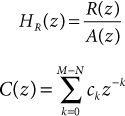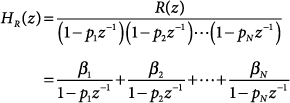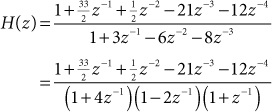Note 47. Inverse z Transform via Partial Fraction Expansion:
Case 2: All Poles Distinct with M ≥ N in System Function (Explicit Approach)
This note presents a procedure for computing the inverse z transform for system functions in which all poles are distinct and the degree, M, of the numerator equals or exceeds the degree, N, of the denominator. The procedure uses polynomial division to convert the improper rational function, H(z), into the sum of a polynomial, C(z), and a proper rational function, HR(z).
In order for a rational function to be expanded as a sum of partial-fraction terms, the degree of the numerator must be less than the degree of the denominator. In cases where M ≥ N, the system function must be restructured as the sum of a polynomial, C(z), and a proper rational function, HR(z):
47.1
![]()
where

This restructuring can be implemented by solving directly for the values of the coefficients in C(z) and R(z) using polynomial division, and then forming a partial fraction expansion for just HR(z) instead of for H(z). This approach is detailed in Design Procedure 47.1 and is demonstrated in Example 47.1. Polynomial division is detailed in Math Box 47.1 on the next page.










